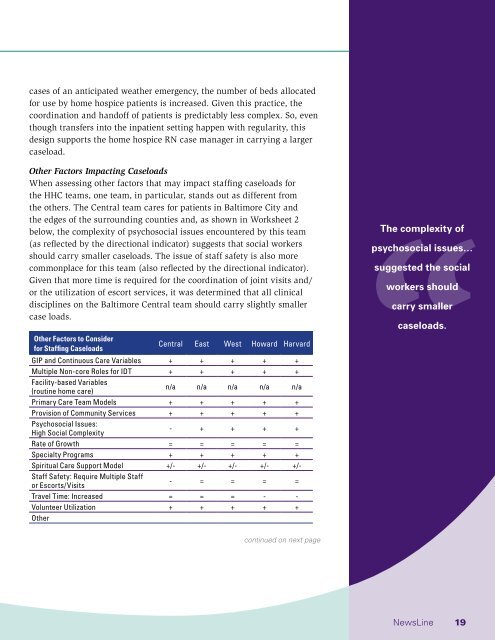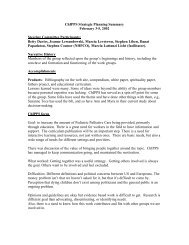PDF version - National Hospice and Palliative Care Organization
PDF version - National Hospice and Palliative Care Organization
PDF version - National Hospice and Palliative Care Organization
Create successful ePaper yourself
Turn your PDF publications into a flip-book with our unique Google optimized e-Paper software.
cases of an anticipated weather emergency, the number of beds allocated<br />
for use by home hospice patients is increased. Given this practice, the<br />
coordination <strong>and</strong> h<strong>and</strong>off of patients is predictably less complex. So, even<br />
though transfers into the inpatient setting happen with regularity, this<br />
design supports the home hospice RN case manager in carrying a larger<br />
caseload.<br />
Other Factors Impacting Caseloads<br />
When assessing other factors that may impact staffing caseloads for<br />
the HHC teams, one team, in particular, st<strong>and</strong>s out as different from<br />
the others. The Central team cares for patients in Baltimore City <strong>and</strong><br />
the edges of the surrounding counties <strong>and</strong>, as shown in Worksheet 2<br />
below, the complexity of psychosocial issues encountered by this team<br />
(as reflected by the directional indicator) suggests that social workers<br />
should carry smaller caseloads. The issue of staff safety is also more<br />
commonplace for this team (also reflected by the directional indicator).<br />
Given that more time is required for the coordination of joint visits <strong>and</strong>/<br />
or the utilization of escort services, it was determined that all clinical<br />
disciplines on the Baltimore Central team should carry slightly smaller<br />
case loads.<br />
Other Factors to Consider<br />
for Staffing Caseloads<br />
Central East West Howard Harvard<br />
GIP <strong>and</strong> Continuous <strong>Care</strong> Variables + + + + +<br />
Multiple Non-core Roles for IDT + + + + +<br />
Facility-based Variables<br />
(routine home care)<br />
n/a n/a n/a n/a n/a<br />
Primary <strong>Care</strong> Team Models + + + + +<br />
Provision of Community Services + + + + +<br />
Psychosocial Issues:<br />
High Social Complexity<br />
- + + + +<br />
Rate of Growth = = = = =<br />
Specialty Programs + + + + +<br />
Spiritual <strong>Care</strong> Support Model +/- +/- +/- +/- +/-<br />
Staff Safety: Require Multiple Staff<br />
or Escorts/Visits<br />
- = = = =<br />
Travel Time: Increased = = = - -<br />
Volunteer Utilization + + + + +<br />
Other<br />
The complexity of<br />
psychosocial issues…<br />
suggested the social<br />
workers should<br />
carry smaller<br />
caseloads.<br />
continued on next page<br />
NewsLine 19









